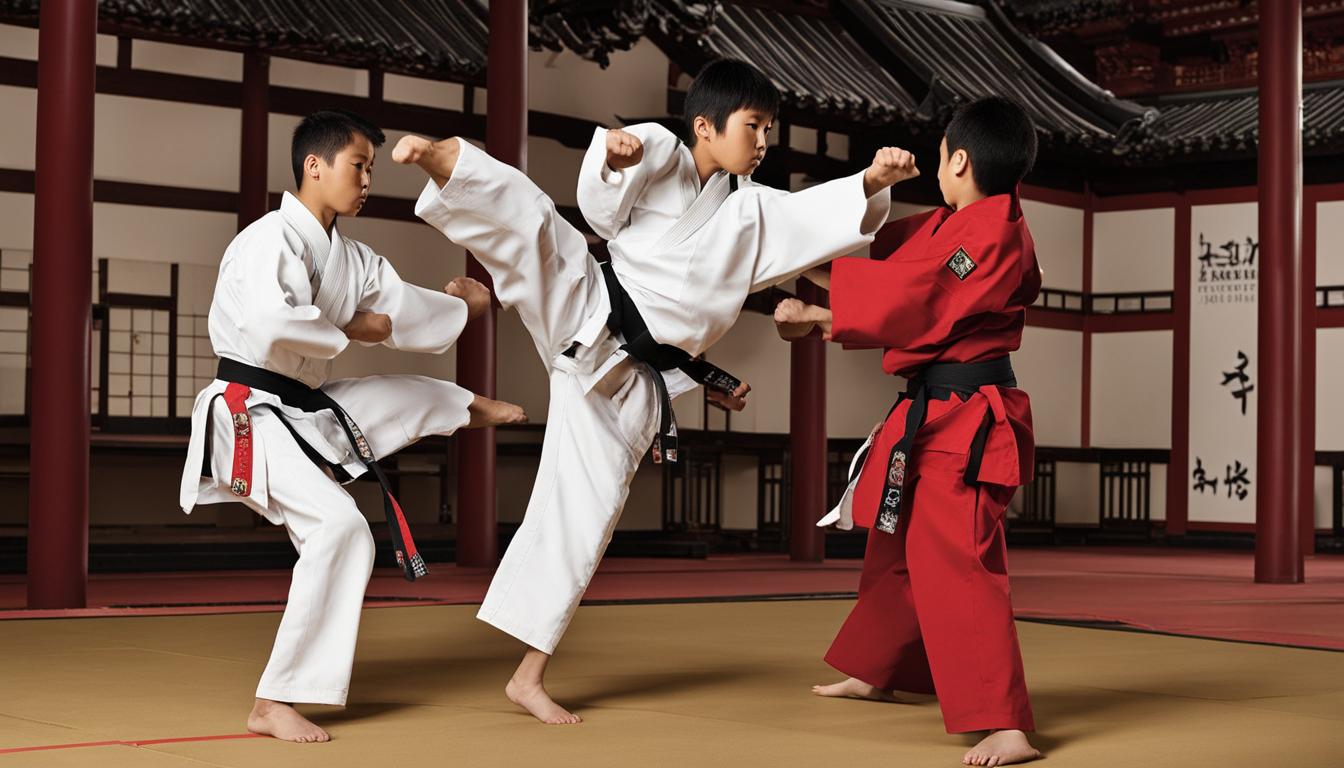Practicing martial arts offers numerous physical and mental health benefits. From self-defense skills to aerobic workouts, muscle building to balance improvement, martial arts provide a holistic approach to fitness. Two popular martial arts that have gained global recognition and are even Olympic sports are karate and taekwondo.
While karate and taekwondo share similarities in terms of learning fundamental rules and moves, they also have distinct differences that make each martial art unique. Understanding these differences can help individuals make an informed choice when deciding which martial art to pursue.
Karate places a strong emphasis on hand techniques and uses kicks as backup, whereas taekwondo focuses more on kicking techniques and utilizes hands as a secondary form of attack. Both martial arts utilize specific stances that are meant for training purposes and may not be practical in real-life combat situations.
Karate has its roots in Japan and China, and various styles of karate have emerged over time, including gōju-ryū, shitō-ryū, shotokan, and wadō-ryū. On the other hand, taekwondo originated in Korea and has ancient origins dating back thousands of years. It was further developed into a more standardized martial art in 1955.
Competitions in karate and taekwondo have their own specific rules and guidelines. In karate, equal points are awarded for punches and kicks, whereas taekwondo gives higher points for kicks. This difference in scoring reflects the distinct emphasis each martial art places on specific techniques.
Both karate and taekwondo use belt systems to signify rank and progression. Karate uses a colored rank system called kyu, which progresses from white to black belts. Taekwondo also uses a colored rank system called geup, which starts at the 10th geup as a white belt and progresses to black belts.
Key Takeaways:
- Karate and taekwondo are popular martial arts that offer numerous physical and mental health benefits.
- Karate emphasizes hand techniques with kicks as backup, while taekwondo focuses more on kicking techniques with hands as a secondary form of attack.
- Karate has Japanese and Chinese influences, with various styles available, while taekwondo has ancient Korean roots.
- Competitions in karate and taekwondo have unique scoring systems, with karate awarding equal points for punches and kicks, and taekwondo giving higher points for kicks.
- Both karate and taekwondo use belt systems to signify rank and progression, with different color-coded ranks.
When choosing between karate and taekwondo, individuals should consider their personal preferences, goals, and the unique characteristics of each martial art. Exploring beginner classes in both karate and taekwondo can help individuals determine which martial art suits them best.
Origins and History of Karate
Karate, a martial art form known for its striking techniques, originated approximately 500 years ago on the Japanese island of Okinawa. Developed as a system of self-defense, karate became popular when weapons were banned on the island.
Karate bears influences from both Japanese and Chinese cultures, as they were exposed to each other during trade and cultural exchanges. The combination of these influences gave birth to the unique techniques and philosophies that define karate.
One influential figure in the history of karate is Funakoshi Gichin, born in 1868. Funakoshi was instrumental in spreading the teachings of karate across Japan. He established the Japan Karate Association, which played a crucial role in the development and promotion of karate as a respected martial art.
Over the centuries, different styles of karate have emerged, each with its own characteristics and lineage. Some notable styles include:
- Gōju-ryū
- Shitō-ryū
- Shotokan
- Wadō-ryū
These styles have unique training methodologies, forms (kata), and approaches to combat. They represent the diversity and evolution of karate as it spread from Okinawa to various parts of the world.
| Style | Origin | Description |
|---|---|---|
| Gōju-ryū | Founded by Miyagi Chōjun | Combines hard and soft techniques |
| Shitō-ryū | Founded by Kenwa Mabuni | Blends Okinawan and Chinese influences |
| Shotokan | Founded by Funakoshi Gichin | Emphasizes powerful and linear movements |
| Wadō-ryū | Founded by Hironori Ōtsuka | Incorporates principles of jujutsu and aikido |
Origins and History of Taekwondo
Taekwondo has a long and rich history that dates back around 2,000 years in Korea. It originated during the ruling of three rival kingdoms, where the need for self-defense against sudden attacks led to the development of this martial art.
However, during the Japanese occupation of Korea, taekwondo was banned, and practitioners were forced to practice in secret through underground teaching and maintaining folk customs. This period of oppression and resistance greatly influenced the evolution of taekwondo.
After Korea was liberated in 1945, new martial arts styles were developed, and taekwondo went through a process of further unification and standardization. In 1955, the Korean Taekwondo Association was established to facilitate this process and promote the art as a unified system.
Today, taekwondo is recognized as a popular martial art practiced worldwide, known for its dynamic kicks, powerful strikes, and emphasis on self-defense and discipline.
To gain a better understanding of the development and significance of taekwondo, refer to the table below for a concise overview of its historical milestones:
| Year | Event |
|---|---|
| 2,000 years ago | Origins of taekwondo during the rule of three rival kingdoms in Korea |
| Japanese occupation of Korea | Taekwondo banned; practice continues underground |
| 1945 | Korea’s liberation; new martial arts styles emerge |
| 1955 | Taekwondo further unified and standardized |
| 1959 | Establishment of the Korean Taekwondo Association |
As you can see, taekwondo’s history is deeply intertwined with the cultural and socio-political context of Korea, making it a martial art that reflects the resilience and spirit of its people.
Techniques in Karate and Taekwondo
When it comes to martial arts, both karate and taekwondo have their own unique set of techniques. Karate is renowned for its emphasis on hand techniques, using kicks as a secondary form of attack. On the other hand, taekwondo places a greater emphasis on kicking techniques, utilizing the legs as the primary weapon.
In karate, practitioners focus on striking and punching techniques, honing their skills to deliver powerful and precise blows. Different karate styles incorporate joint manipulations, locks, and throws to immobilize and control opponents. The use of hand techniques in karate requires precision and accuracy, enabling practitioners to effectively strike vital points on the body.
Taekwondo, in contrast, is known for its dynamic and powerful kicks. Practitioners of taekwondo train extensively in various kicking techniques, including spinning kicks and jumping kicks. The techniques in taekwondo are designed to maximize the power and reach of the legs, making it an effective martial art for self-defense and competition. The leg, considered one of the longest and strongest weapons in the human body, forms the foundation of taekwondo techniques.
Overall, both karate and taekwondo offer practitioners a diverse range of techniques, each with its own specialized focus. The hand techniques of karate and the kicking techniques of taekwondo provide practitioners with a well-rounded skillset, allowing them to adapt to different situations and opponents.
These martial arts techniques not only enhance physical strength and coordination but also promote mental discipline and focus. Whether one chooses to train in karate or taekwondo, they will gain valuable skills in self-defense and develop a deeper understanding of martial arts.
Competitive Differences in Karate and Taekwondo
Both karate and taekwondo have specific rules and guidelines for their competitions. Understanding these differences is essential for participants and spectators alike.
Scoring in Karate
Karate competitions typically award equal points for punches and kicks. However, scoring is not solely based on quantity; specific criteria determine the quality of strikes. Judges consider factors such as form, distance, application, timing, and attitude when awarding points. This ensures a fair assessment of technique execution and overall performance.
Scoring in Taekwondo
Taekwondo competitions employ a different point system, placing higher emphasis on kicks. Kicks to the head earn the most points, followed by kicks to the body and kicks below the belt. Strikes using hands receive fewer points compared to kicks. This scoring system highlights the dynamic kicking techniques that distinguish taekwondo from other martial arts.
In major taekwondo competitions, electronic scoring systems are often used to register valid attacks. These advanced technologies ensure accurate and efficient scoring, contributing to the integrity and transparency of the competition.
| Competitive Differences in Karate and Taekwondo | |
|---|---|
| Scoring in Karate | Scoring in Taekwondo |
| Karate competitions award equal points for punches and kicks. | Taekwondo competitions give higher points to kicks, with kicks to the head earning the highest points. |
| Specific criteria such as form, distance, application, timing, and attitude are considered when awarding points in karate. | Taekwondo competitions have different point systems for different techniques, giving a greater weightage to head and body kicks. |
| In major taekwondo competitions, electronic scoring systems are often used to register valid attacks. |
Belt Systems in Karate and Taekwondo
Both karate and taekwondo utilize belt systems as a means to indicate rank and progression within the martial art. These belt systems serve as a visual representation of the practitioner’s skill level and experience.
Karate Belt System
In karate, the belt system consists of different colored ranks known as kyu. The journey begins with the white belt, symbolizing a beginner’s level, and progresses through various colors such as yellow, orange, green, blue, purple, and brown. The highest rank achievable in karate is the black belt, which is a testament to the practitioner’s dedication, discipline, and mastery of the martial art. Within the realm of black belts, there are several levels known as dan, starting at the first dan.
Taekwondo Belt System
Taekwondo also employs a belt system to signify rank and advancement. The belt system in taekwondo begins with the 10th geup as a white belt. As practitioners gain proficiency, they progress through various colored belts, including yellow, green, blue, red, and finally, black. Similar to karate, the black belt represents the highest level of achievement in taekwondo. The black belt ranks in taekwondo are called dan, with the journey starting at the first dan.
Both karate and taekwondo place great importance on the process of advancing through the belt system. It serves as a motivator and a gauge for personal development in the respective martial arts.
The image depicts various karate and taekwondo belts, showcasing the different colors and levels of rank within each martial art. It serves as a visual representation of the belt systems discussed in this section, emphasizing the significance of progression and achievement in karate and taekwondo.
Conclusion
Karate and taekwondo are two valuable martial arts that provide numerous physical and mental benefits. These disciplines have their own unique techniques, origins, and competitive structures. Karate focuses on hand techniques and uses kicks as a backup, while taekwondo places a greater emphasis on kicking techniques. Karate draws influences from both Japanese and Chinese martial arts, while taekwondo traces its roots back to ancient Korea.
When choosing between karate and taekwondo, personal preferences and goals play a crucial role. Those seeking a martial art that emphasizes hand strikes and involves a balance of kicks and punches may find karate to be a suitable choice. On the other hand, individuals who have a preference for powerful and dynamic kicks might gravitate towards taekwondo. Both arts provide a path to physical fitness, self-discipline, and personal growth.
To make an informed decision, it is recommended to try beginner classes in both karate and taekwondo. By doing so, practitioners can experience the training methods, coaching styles, and overall atmosphere of each martial art. This hands-on approach can help individuals determine which discipline aligns best with their interests and aspirations. Whether one chooses karate or taekwondo, both paths offer opportunities for self-improvement and the pursuit of martial arts excellence.


